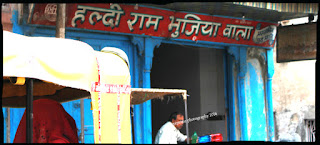Chasing Temples in the Capital of Mallabhum - 3
4 day trip including journey dates
By Moutushi Ghoshdeysarkar
Day 1 || Day 2 || Day 3 || Day 4
Terracotta or baked earth art is extensively in use in West Bengal, from temples to jewellery, decorative sculptures to tiles and everything in between. The rest of India and abroad also adores terracotta, for its pliability which helps give form to a plethora of ideas that is bound only by one’s imagination.
The sun was shining bright negating the weather forecast and we set out to shoot all that we could at will. 24 temples was a bit too over the top sort of a target but one must try.
This time we started from the nearest one. Rasmanch. You got to buy a ticket, Rs.15 per head, it also pays for two other temples maintained by ASI, Pancha Ratna and Jor Bangla.
Rasmanch is a raised platform for displaying the idols of Radha and Krishna from temples around on a particular occasion. It has the essence of a step pyramid to it. There are loads of Drongos for the bird lovers.
A 10 min walk along the canal took us to the Gumgarh, which is a very ancient structure and is yet to reveal its purpose to the archaeologists.
The famed Pancha Ratna temple is another 5 min walk. We found it being renovated and thus could not capture this one of a kind beauty with 5 pinnacles; the images we took are like that of a bandaged heroine.
Further up the road, we found a twin temple which now has the privilege to witness martial arts training.
The Mrinmoyee temple comes up next as we keep going along the road. Built in 997 AD, this temple houses goddess Durga and is alive with the sacred rituals being performed till date.
Bang opposite to the Mrinmoyee temple on the main road is the Radheshyam temple. Across the grounds beside it, where children were happily playing is another hottie the Laljiu temple.
Marching backward through the grounds onto a mud lane on the other side of Radheshyam temple we found Jor Banglo, the most famous of them all. It had a small contingent of makeshift shops in front of the entrance selling souvenir and also some local specialties like the cotton towels the size of almost a bedspread for peanuts.
We had refreshments at an open-air spread out shop which had benches to sit, tea, biscuits of all sorts, sour, sweet, sweet and sour, chocolate flavoured, adorned with nuts and many more. It also had a dish favoured by most Bengalis, the ‘ghugni’ which was on offer with or without bun. ‘ghugni’ is black gram or dried yellow peas or dried white peas cooked with gravy, in the traditional eastern Indian style.
A mud lane from the gate leads up to the Mrinmoyee temple, we went past the temple looking for a place to relieve ourselves and found one behind it. It is a ‘Sulabh’ sort of a place, not so unclean and usable. The keeper, however, was very confused about what to charge. He wanted to ask something big but was suddenly mobbed as a bigger group came around. This group had ‘English speaking Bengalis’ who loved to throw their weight around and the poor fellow was completely mellowed. We paid him the dues and went off.
We walked and walked and walked, through the big and small gate of the fort walls that once stood there, down into the densely populated part of the town through winding roads, left and right, asking local guides and finally hiring a rickshaw to reach Madanmohan Temple.
A man very humbly dressed offered me ‘prasad’(anything edible that has been offered to the god), it was some variance of the ‘khichri’(rice and pulses cooked together) and it was nice. The man said he had made it himself at home.
From this temple which was deep into the heart of a maze of lanes, we tried reaching out to other temples but that seemed impossible on foot. After a good amount of trekking when we were about to give up we got a ‘toto’(a battery operated three-wheeler which does not need a license to be driven; this is restricted only to West Bengal).
A couple of more temples could be covered thanks to the ‘toto’, but most were in a dilapidated state, being family owned who were unable to bear the cost of a proper maintenance. In some, the deity is actively worshipped and is expected to take care of the structure with its divine grace.
Back in the tourist lodge, we had a late lunch and soon after went out shopping for curios. I bought terracotta neckpieces for reselling; Rajib bought a ‘dokra’ artifact modeled on the famed canon that is called ‘Dal Madol’ which can be seen on display in a small courtyard near Chinnamasta temple. It was made around 1600 AD, was lost after the Malla dynasty declined only to be found by the British.
Legend has it that Lord Krishna himself used the canon to ward off the enemies.
We bought a few more souvenirs for ourselves and as gifts including the famous ‘dashavatar cards’ which is handmade on cloth and depicts the 10 avatars of Vishnu. Its a Mallabhum specialty, collectible item.
The day was well spent culminating with a flavoursome dinner at the lodge and speculations about our next and final day at Bishnupur.
Time management was crucial on the last day, as we still had a few important temples to visit, travel 44kms to and fro to visit a village called Panchmura where they make the famous terracotta horses and other artifacts and catch a train back home at 3 pm.
Day 1 || Day 2 || Day 4
Temple List::Bishnupur
https://en.wikipedia.org/wiki/List_of_temples_in_BishnupurDay 1 || Day 2 || Day 4



















Comments
Post a Comment